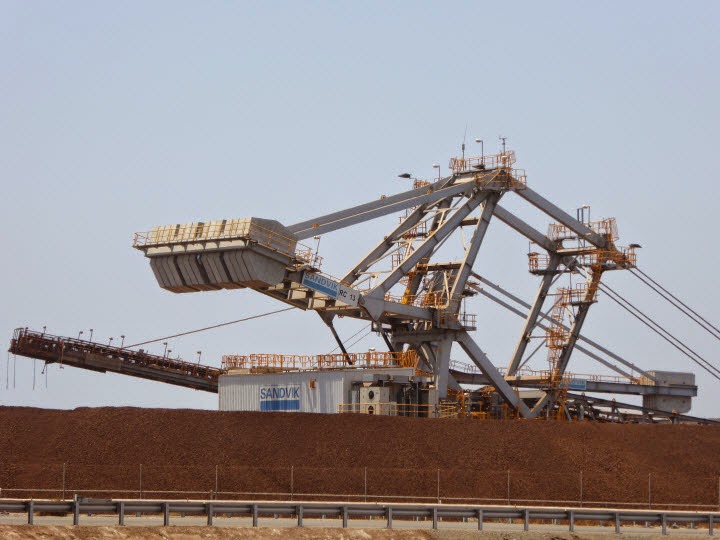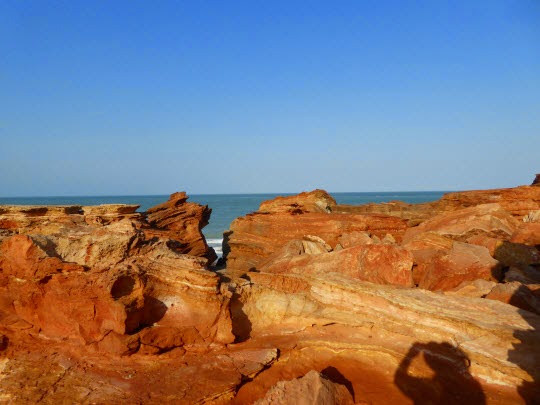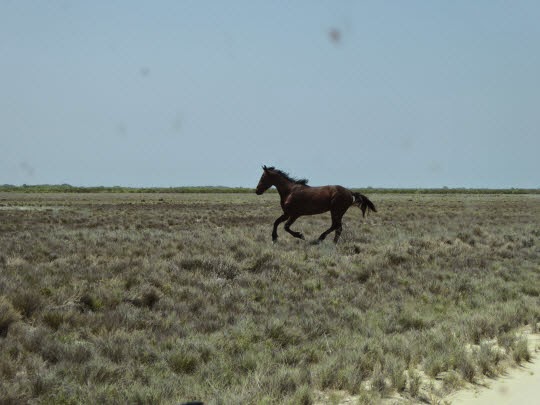Karratha is about 850 kilometres south west along the coast from Broome. There isn't much along the way until you get to Port Headland, which is very busy with trains, road trains and all sorts of other mining related vehicles. It appeared to me like Port Headland was dominated by BHP, judging by some of the road signs. I didn't stop and pressed on towards Karratha, but got only as far as Roebourne, where I got into my first traffic jam since I left Sydney weeks ago. The reason was that the highway was closed because of a bush fire. I waited in the queue for about 1/2 hour just outside town, but then decided I might as well use the time to have a bit of a look around. I went to the tourist information office, which is housed in the old Roebourne Gaol. The lady looking after the place gave me a map of the area and explained for about 20 minutes what I should have a look at during my stay in Karratha. Basically Karratha itself is a service town for the mineral and gas industry in the area, so it is the surrounds that are really of interest. I decided to fill my three days by exploring the north of Karratha on day one, the south on day two, and take a cruise around the Dampier Archipelago on day three.
Because the road was still closed, I took a closer look around the old gaol, which now serves as a museum for the town of Roebourne. I learned that Roebourne was first settled by sheep farmers back in 1864. Apparently there was a law that convicts couldn't be put to labour north of the topic of Capricorn, so the first settlers "persuaded" the local Aboriginals to sign work contracts. There was another law that when an employee broke their work contract he could be pursued, jailed and put to hard labour as a prisoner. Because many of the press-ganged workforce didn't actually understand what they got themselves in for, many of them ended up as working prisoners in Roebourne gaol. The sheep farmers took to pearling in the off season, and soon the pearling trade started to flourish in the area, until it moved north to Broome about 20 years later.
It took about two hours before they re-opened the highway. There was a section where the fire was still encroaching on the road, and as with all the spinifex grass fires that I have driven through over the last couple of weeks, the heat was bearable, but the smoke really affected visibility.
I arrived in Karratha just as the sun set. The place where I stayed was a donga in a workers camp outside of town in an industrial estate and still more expensive than the one bedroom apartment with sea view that I had in Broome. This is the Pilbara region for you. It is still booming with mineral and gas exploration. Like Port Headland was dominated by BHP, so is Karratha dominated by Rio Tinto and Woodside. The town was only started in the eighties when the town of Dampier got too small for all the new industries. Driving through Karratha reminded me a bit of Canberra. Lots of high density suburbs with houses right up to the edge of their block and a huge shopping mall in the centre of town.
On the first morning I got up at 5 AM, because everyone else did and they reversed their trucks out of the car park, beep... beep... beep. I drove back to Roebourne, which is north of Karratha and then turned left towards Point Samson. Roebourne is inland, and its first port was a town called Cossack, which was also the first port of call of my tour on day one. Cossack is no longer inhabited, other than by a couple of caretakers. Yet many of the old buildings still exist and tell the story of past times. I spent a couple of hours looking at the sites, taking in some of the old buildings, a couple of lookouts, settler's beach and the cemeteries. There are two of them, one for the Europeans and one for the Japanese that came with the pearl industry. The grave for the oldest person that I could find was 65 years, most of them died in infancy or at the age between 40 and 50; it must have been a tough life. One grave was that of a girl that died from tetanus after standing on a rusty nail in the school yard (I read the story at the school house and then found the grave later).
Cossack only had a short live. The pearl industry moved north to Broome, the harbour got too shallow for the larger vessels and to top it all off it got devastated by a cyclone. In 1910 a new port was opened in Point Samson, which is where I went next. Point Samson is a small town with a pub, a general store, a couple of bed & breakfasts and two large caravan parks. It has a small boat harbour and you can still see some remains of the old jetty that replaced the port of Cossack. However, if you go up to the local lookout you can see the new port, just north of the town where they load huge iron ore carriers.
After Point Samson I drove through the town of Wickham to the other side of the peninsula, getting closer to the new port. Unfortunately you can't actually see the port, but you get close enough to see the section where they unload the trains onto the iron ore stockpiles that are then shipped to China. It was good to see a train up close to see how big the carriages were, because on the previous day I was stuck on the road next to the railway and counted a train with 200 carriages. It must have been almost 2 km long.
On the way back from the port I stopped in Wickham and bought some bait and then headed back to Cossack to try my luck with the local sea life. I first did some beach fishing near the cemetery, where my bait was mainly eaten by mud crabs. Then, when the tide was high, I moved to the old Cossack Wharf and there it was an absolute feeding frenzy. I caught a sergeant major fish, which is no good for eating, and then got a large queen fish, but it broke the line before I could land it. I was only using a hand line, with which I need to practice a lot more.
On day two I decided to explore the south of Karratha, where you find the town of Dampier and the Burrup Peninsula. I started by driving towards the Burrup Peninsula, but then taking the first right towards Hearson's Cove. The lady at the Roebourne tourist information told me to go to Deep Gorge, which is on that road, and take a look at the aboriginal rock carvings. There were no signs to Deep Gorge, but I found the car park that she mentioned and started to walk into what I perceived to be the gorge. After about a kilometre I met an English couple who were also looking for the rock art and couldn't find any. They had a rudimentary hand drawn map showing where to look, but they said that they walked to the end of the track without success, so turned around. I kept on walking to the end of the track and noticed that there was a faint track following the valley further up, so I decided to march on. At the end of the valley I got over a ridge and a new valley opened up, with views right down to Port Dampier. From the map that they had I remembered to look out for a pile of shells, where the tribes used to feast, and I did find a sizeable mound of shellls about another 20 minutes into the second valley. On a rocky heap near the shells I saw what I took to be some rock art, so decided to take a picture and turn around because it was getting very hot and I was about an hour's walk away from the car park, with no one else around. When I returned to the car park the English couple were still there, saying they got worried about me and decided to wait for my return. Good to know that there are people who care! They also told me that we were looking in the wrong place and that the rock art only just about 200 metres around the corner from the car park. I did go to take some more pictures, but I was still proud to have found some rock art that was a lot more remote.
After my 2 1/2 hour excursion into the desert I was quite hot and needed to cool down, so I drove to the North West Shelf Project visitor centre, which I assumed would be air conditioned. And it was. A very friendly lady bade me welcome and took me to an auditorium where she played a movie that explained all about the North West Shelf Gas Project to me.It was started back in the eighties by Woodside, and these days is a collaboration of Woodside, BHP, BP, Shell and Chevron. It drills down into the sea bed about 135 km off the coast and collects gas and some oil. It accounts for over 40% of Australia's oil and gas production. The visitor centre was located on a hill overlooking the gas processing plant, from where gas is transported overseas via ships and down to Perth via pipeline. The numbers were staggering and the plant was huge. The total investment is something like 27 billion dollars so far. Anyway, it was air conditioned and I soon cooled down enough to go and have a look at the town of Dampier.
Just before you get into Dampier you will find the memorial to the red dog, who is a legend in this region. Apparently he is buried somewhere between Dampier and Roebourne in an unmarked grave. If you don't know the story I strongly recommend that you get your hands on the movie (it will bring tears to your eyes).
Dampier itself is not that exciting. It has a large bulk shipping port from which Rio Tinto sends salt an iron ore around the world. Apparently Rio Tinto started as Dampier Salt Ltd., and there is a lookout sponsored by them from which you get a good view over the port, with the iron ore and salt stock piles in the distance, waiting to be shipped.
I needed to post a letter to Switzerland, so I drove into the town centre to look for the post office. There wasn't one and the rest of the town centre was equally deserted. The life really happens in Karratha these days. After I posted my letter (in Karratha) I drove back to Hearson Cove to spend the afternoon at the beach.
The third day in Karratha I was planning to cruise around the Dampier Archipelago. There is only one tour provider, called Discovery Cruises. Both the Roebourne and Karratha tourist information told me to call the skipper directly, which I did repeatedly, but I always got the message bank, and he never replied. Either he must have sunk, or was not interested in doing business, with the result that I can't report to you on his activities. Because there really wasn't anything else to do in Karratha I cut my losses and headed off towards Exmouth on the third day.
 |
| Old Roebourne Gaol Museum and Tourist Information |
Because the road was still closed, I took a closer look around the old gaol, which now serves as a museum for the town of Roebourne. I learned that Roebourne was first settled by sheep farmers back in 1864. Apparently there was a law that convicts couldn't be put to labour north of the topic of Capricorn, so the first settlers "persuaded" the local Aboriginals to sign work contracts. There was another law that when an employee broke their work contract he could be pursued, jailed and put to hard labour as a prisoner. Because many of the press-ganged workforce didn't actually understand what they got themselves in for, many of them ended up as working prisoners in Roebourne gaol. The sheep farmers took to pearling in the off season, and soon the pearling trade started to flourish in the area, until it moved north to Broome about 20 years later.
 |
| Once a prisoner was put in chains they stayed on for the duration, 24x7 |
 |
| Driving through the bush fire area |
I arrived in Karratha just as the sun set. The place where I stayed was a donga in a workers camp outside of town in an industrial estate and still more expensive than the one bedroom apartment with sea view that I had in Broome. This is the Pilbara region for you. It is still booming with mineral and gas exploration. Like Port Headland was dominated by BHP, so is Karratha dominated by Rio Tinto and Woodside. The town was only started in the eighties when the town of Dampier got too small for all the new industries. Driving through Karratha reminded me a bit of Canberra. Lots of high density suburbs with houses right up to the edge of their block and a huge shopping mall in the centre of town.
On the first morning I got up at 5 AM, because everyone else did and they reversed their trucks out of the car park, beep... beep... beep. I drove back to Roebourne, which is north of Karratha and then turned left towards Point Samson. Roebourne is inland, and its first port was a town called Cossack, which was also the first port of call of my tour on day one. Cossack is no longer inhabited, other than by a couple of caretakers. Yet many of the old buildings still exist and tell the story of past times. I spent a couple of hours looking at the sites, taking in some of the old buildings, a couple of lookouts, settler's beach and the cemeteries. There are two of them, one for the Europeans and one for the Japanese that came with the pearl industry. The grave for the oldest person that I could find was 65 years, most of them died in infancy or at the age between 40 and 50; it must have been a tough life. One grave was that of a girl that died from tetanus after standing on a rusty nail in the school yard (I read the story at the school house and then found the grave later).
 |
| Cossack Court House |
 |
| Inside one of the old stores |
 |
| Laura died aged 10 after standing on a rusty nail |
 |
| Point Samson Pub (nice veranda) |
 |
| Remains of the old jetty |
 |
| Iron ore stock pile at the port |
 |
| Iron ore carriages |
 |
| Cossack Wharf at low tide (high tide was 5 meters higher) |
 |
| Where do I start looking for rock art? |
 |
| Near the sea shells in the desert |
 |
| Not much, but it looks man-made, and I found it by myself |
 |
| Some of the rock-art where I was supposed to go (near car-park) |
 |
| Part of the gas processing plant |
 |
| Red dog memorial |
 |
| Salt stock piles at Dampier Port |
 |
| Hearson Cove |






























